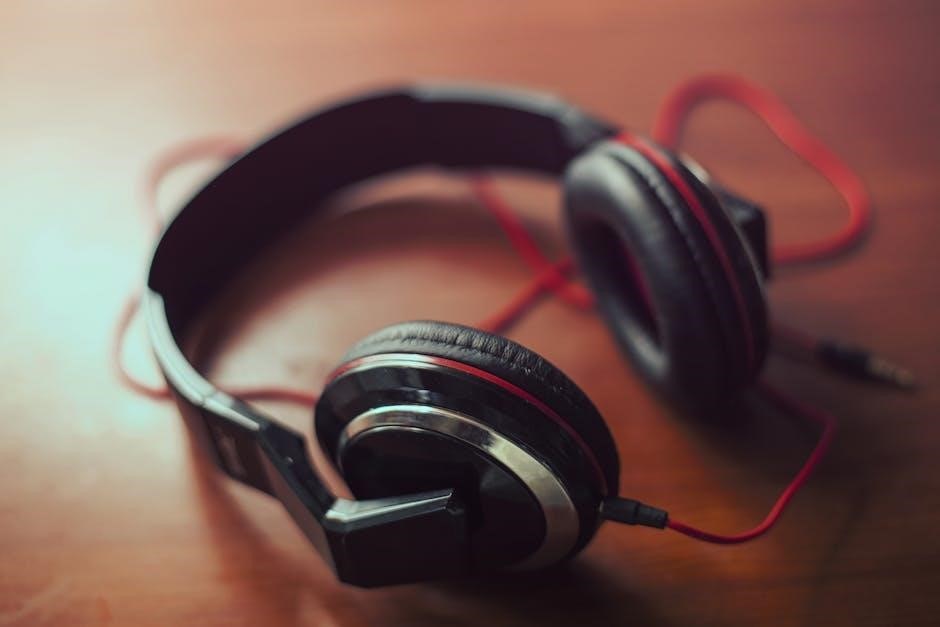Discover the importance of choosing the right ear plug size for optimal comfort, hearing protection, and effectiveness in various activities like concerts, sleeping, and swimming with our comprehensive guide.
Why Ear Plug Size Matters
Ear plug size plays a crucial role in ensuring optimal comfort, noise reduction, and overall effectiveness. A proper fit prevents discomfort and potential hearing damage, while an ill-fitting plug may fail to block noise adequately. Poorly sized ear plugs can cause soreness or fall out, especially during activities like swimming or concerts. Conversely, a plug that’s too tight may restrict blood flow or cause long-term discomfort. The right size ensures a seal that balances protection and comfort, making it essential for both short-term use and extended wear during sleep or work. Choosing the correct size is vital for maximizing hearing protection and user satisfaction in any setting.
Who Needs an Ear Plug Size Guide?
Anyone seeking optimal comfort and hearing protection benefits from an ear plug size guide. This includes musicians, swimmers, construction workers, travelers, and individuals with unique ear canal sizes. First-time users often struggle with sizing, making this guide indispensable. Regular ear plug users, such as those working in noisy environments or attending loud events, also benefit. People with specific needs, like small or large ear canals, will find tailored recommendations. Essentially, anyone wanting to ensure a proper fit for comfort and effectiveness should consult this guide to make informed decisions and enhance their hearing health.

Understanding Ear Anatomy and Ear Plug Fit
Ear anatomy varies significantly, with ear canal size and shape impacting fit. Understanding these factors ensures proper comfort and effectiveness of ear plugs for hearing protection.
The Importance of Ear Canal Size and Shape
Ear canal size and shape play a crucial role in determining the effectiveness of ear plugs. Variations in ear anatomy can significantly impact how well ear plugs fit, affecting both comfort and noise reduction. A proper fit ensures that the ear plugs seal the ear canal effectively, preventing sound from entering and reducing the risk of discomfort or irritation during extended use.
Understanding ear canal dimensions helps in selecting ear plugs that accommodate individual differences, whether the ear canal is narrow, wide, short, or long. This customization ensures optimal performance and prevents common issues like inadequate noise blockage or excessive pressure, making ear plugs more reliable for their intended purpose.
How Ear Plug Sizes Relate to Comfort and Effectiveness
Ear plug sizes directly impact both comfort and effectiveness. A well-fitted ear plug ensures proper noise reduction while maintaining comfort during extended use. Incorrect sizing can lead to inadequate noise blockage or discomfort, potentially causing irritation or fatigue. The right size ensures the ear plug seals the ear canal effectively, preventing sound leaks and reducing pressure buildup, which is essential for activities like sleeping, swimming, or attending loud events. Proper sizing enhances the overall performance of the ear plug, making it more reliable for its intended purpose while ensuring a pleasant user experience.

Types of Ear Plugs and Their Sizes
Explore various ear plug types, including flanged, tapered, mushroom, and custom-made, each offering unique size options to suit different needs and preferences for optimal fit.
Flanged Ear Plugs: Sizes and Features
Flanged ear plugs are a popular choice for their multiple ridges or “flanges,” which provide a secure fit in the ear canal; These plugs come in various sizes, including small, medium, and large, catering to different ear canal diameters. The flanges create a tight seal, enhancing noise reduction and comfort. Made from soft silicone or foam, they are durable and easy to clean. Flanged ear plugs are ideal for loud environments like concerts or construction sites. Their versatility and effectiveness make them a top option for those seeking reliable hearing protection without compromising on comfort or style.
Tapered Ear Plugs: How to Choose the Right Size
Tapered ear plugs are designed with a conical shape, narrowing from the base to the tip, ensuring a snug and secure fit in the ear canal. To choose the right size, consider both the length and width of your ear canal. Measure using a sizing chart or by testing different sizes to find the one that feels most comfortable without causing discomfort or pressure. Tapered ear plugs are available in materials like soft foam or silicone, offering durability and easy insertion. They are ideal for activities such as concerts or swimming, where a reliable seal is essential. Testing various sizes and consulting a professional can help ensure the best fit for optimal hearing protection and comfort.
Mushroom Ear Plugs: Size Options and Fit
Mushroom ear plugs feature a unique design with a wider base and a narrower tip, providing a secure fit in the ear canal. Available in various sizes, they cater to different ear shapes and preferences. The flared base ensures easy insertion and removal, while the tapered tip offers a comfortable fit. Made from materials like silicone or foam, mushroom ear plugs are durable and adaptable. To determine the right size, consider the depth and width of your ear canal. Proper fit is essential to avoid discomfort and ensure effective noise reduction. Whether for sleeping, swimming, or concerts, mushroom ear plugs are a versatile choice for hearing protection and comfort.
Custom-Made Ear Plugs: Precision Sizing
Custom-made ear plugs offer unparalleled precision sizing, tailored to the unique shape and size of your ear canal. Created from molds taken by an audiologist or hearing specialist, these ear plugs provide a perfect fit, ensuring maximum comfort and noise reduction. Made from durable materials like silicone, they are designed to last and adapt to your ear’s specific contours. Custom ear plugs are ideal for individuals with irregular ear anatomy or those seeking superior hearing protection. Available in various styles, including options for swimming, concerts, or sleeping, they offer a personalized solution for any activity. While they may require a higher initial investment, their long-term benefits for hearing health and comfort make them a worthwhile choice.

How to Measure Your Ear Canal for the Perfect Fit
To measure your ear canal accurately, use a flexible ruler or a paper strip. Stand in front of a mirror, gently pull your ear back to straighten the canal, and measure both the depth and the diameter of the ear canal opening. Compare these measurements to an ear plug size chart to determine your ideal fit. For added accuracy, consider using a sizing gauge from an ear plug kit or consulting an audiologist for professional guidance.
Using a Sizing Chart: Step-by-Step Guide
To use an ear plug sizing chart effectively, start by gathering a flexible ruler or a paper strip. Stand in front of a mirror, gently pull your outer ear back to straighten the ear canal, and measure the depth from the opening to the eardrum. Next, measure the width of the ear canal opening. Compare these measurements to the sizing chart provided by the manufacturer or supplier. Ensure the ear plug size aligns with your measurements for optimal fit. For added accuracy, consider using a sizing gauge or consulting an audiologist. Proper sizing ensures comfort and effective noise reduction.
Measuring Ear Canal Length and Width
Measuring your ear canal accurately is crucial for selecting the right ear plug size. Stand in front of a mirror, gently pull your ear back to straighten the canal, and use a flexible ruler or caliper to measure. The length is the distance from the ear opening to the eardrum, while the width is the diameter of the canal. Average ear canals range from 0.7 to 1.1 inches in length and 0.2 to 0.4 inches in width. Record these measurements and compare them to the sizing chart. For precise fit, consider using a paper strip to measure the width by inserting it gently until resistance is felt.
Ear Plug Size Chart: A Comprehensive Guide
Explore our detailed chart featuring small, medium, large, and extra-large sizes, designed to help you find the perfect fit for sleeping, swimming, or concerts.
Small, Medium, Large, and Extra-Large Sizes Explained
Ear plugs come in four primary sizes: small, medium, large, and extra-large, catering to diverse ear canal diameters. Small sizes are ideal for narrower canals, often preferred for children or those with petite ears. Medium and large sizes are the most common, fitting average ear canals and offering a balance of comfort and protection. Extra-large sizes are designed for wider canals, ensuring a secure fit for louder environments like concerts or construction sites. Each size is tailored to specific needs, ensuring optimal noise reduction and comfort. Proper sizing is crucial for effectiveness, as ill-fitting ear plugs may compromise hearing protection or cause discomfort during extended use.
How to Interpret the Size Chart for Your Needs
To interpret the size chart effectively, match your ear canal measurements to the corresponding size category. Small sizes suit narrower canals, while extra-large fits wider ones. Consider your primary use—whether for sleeping, swimming, or concerts—to prioritize noise reduction or comfort. Medium and large sizes are versatile for average canals. Ensure a snug fit to avoid discomfort or reduced effectiveness. Refer to the chart’s guidelines for activity-specific recommendations, such as tighter seals for water activities or softer materials for sleep. Proper interpretation ensures optimal protection, comfort, and performance tailored to your lifestyle and auditory needs, making the chart an essential tool for selecting the right ear plugs.
Choosing the Right Ear Plug Size for Different Activities
Optimal ear plug size varies by activity; smaller sizes suit sleeping, medium sizes work for swimming, and larger sizes are ideal for concerts, ensuring comfort and noise reduction.
Ear Plugs for Sleeping: Size and Comfort Considerations
For restful sleep, choosing the right ear plug size and material is crucial. Smaller sizes are often preferred for sleeping, as they fit snugly without causing discomfort. Soft foam or silicone ear plugs are ideal due to their ability to mold to the ear canal, providing a secure fit and effective noise reduction. Look for tapered designs that allow for easy insertion and minimize pressure on the ear. It’s important to test different sizes to ensure proper fit without feeling cramped. Comfort is key for long-term wear, so opt for hypoallergenic materials if sensitive. Proper fit ensures uninterrupted sleep and protects hearing health.
Ear Plugs for Swimming: Sizing for a Secure Fit
When swimming, ear plugs must fit snugly to prevent water from entering the ear canal, reducing the risk of infections. Opt for smaller to medium sizes, as they often provide a secure fit without causing discomfort. Silicone ear plugs are highly recommended for swimming due to their waterproof properties and durability. Look for designs with multiple flanges or tapered shapes, as they create a tighter seal. Custom-molded ear plugs are ideal for competitive swimmers, offering precise sizing and superior protection. Always test the fit before swimming to ensure comfort and effectiveness. Properly sized ear plugs will help you enjoy water activities without compromising hearing health.
Ear Plugs for Concerts: Balancing Size and Noise Reduction
At concerts, ear plugs must balance size and noise reduction to protect hearing without muffling sound quality. Opt for mid-sized ear plugs, as they often provide the right fit for most ear canals while maintaining audio clarity. High-fidelity ear plugs with multiple filters are ideal, offering precise noise reduction across frequencies. Foam ear plugs are a cost-effective option, but silicone or custom-molded designs may offer better comfort and sound clarity. Ensure the plugs are snug but not too tight to avoid discomfort during long events. Proper sizing ensures effective noise reduction while preserving the musical experience, safeguarding your hearing from potential damage caused by loud concert environments.
Common Mistakes When Selecting Ear Plug Sizes
Common mistakes include choosing sizes too small, causing discomfort and inadequate noise reduction, or too large, leading to poor fit and potential fall-out during use.
Choosing a Size Too Small or Too Large
Selecting an ear plug size that is either too small or too large can lead to discomfort and reduced effectiveness. A size too small may cause the ear plugs to fit loosely, failing to block noise adequately and potentially falling out during activities. On the other hand, a size too large can cause pressure on the ear canal, leading to soreness or discomfort over time. Both scenarios compromise the primary purpose of ear plugs, which is to provide reliable noise reduction and comfort. Proper sizing ensures a snug fit that balances comfort and effectiveness, making it essential to measure accurately and choose the right size for your specific needs.
Ignoring the Importance of Material and Flexibility
Overlooking the significance of ear plug material and flexibility can lead to discomfort and reduced performance. Materials like foam, silicone, or wax offer varying levels of noise reduction and comfort. Rigid materials may cause soreness, while overly soft ones might not seal properly. Flexibility is crucial for adapting to the ear canal’s unique shape, ensuring a secure fit. Ignoring these factors can result in poor noise reduction, discomfort, or even damage to the ear canal. Prioritizing material quality and flexibility ensures long-lasting comfort and effective noise blocking, making it vital to consider these aspects when selecting ear plugs for any activity or need.

How to Ensure Proper Fit and Comfort
Ensure your ear plugs fit perfectly by testing sizes, adjusting for comfort, and securing a snug fit to maximize noise reduction and long-term wearability.
Testing Different Sizes: A Trial-and-Error Approach
Testing different ear plug sizes is essential to find the perfect fit. Start by trying each size, ensuring a snug yet comfortable fit in your ear canal. If a size feels too tight or loose, move to the next option. Pay attention to how each size performs during activities like sleeping, swimming, or attending concerts. The goal is to achieve a balance between effectiveness and comfort. Be patient, as this process may take time, but it ensures you find the ideal size for optimal hearing protection and long-term wearability.
Adjusting Ear Plugs for Optimal Comfort
Adjusting ear plugs is crucial for ensuring a comfortable and secure fit. Start by gently rotating the ear plug while inserting it into the ear canal to allow it to expand and mold to your anatomy. For flanged or tapered styles, a slight squeeze before insertion can enhance fit. Avoid over-tightening, as this can cause discomfort or pressure points. If the plug feels loose, try repositioning it or using a different size. Everyone’s anatomy is unique, so patience and minor adjustments are key to achieving the perfect balance of comfort and effectiveness. Proper adjustment ensures long-term wearability and optimal hearing protection.

Maintenance and Care for Your Ear Plugs
Proper cleaning with mild soap and water, followed by thorough drying, ensures hygiene. Store ear plugs in a protective case to maintain shape and longevity.
Cleaning and Sanitizing Ear Plugs
Regular cleaning and sanitizing of ear plugs are essential for maintaining hygiene and effectiveness. Use mild soap and warm water to gently scrub the surface, avoiding harsh chemicals that may damage materials. Rinse thoroughly and dry completely to prevent moisture buildup, which can lead to bacterial growth. For added sanitization, alcohol-based wipes can be used on non-porous materials like silicone or wax plugs. Always clean ear plugs after each use to ensure optimal performance and prevent the spread of infections. Proper care extends the lifespan of your ear plugs while keeping them safe and functional for repeated use.
Storing Ear Plugs to Maintain Their Shape and Size
Proper storage is crucial to maintain the shape and size of your ear plugs. Use a protective case or pouch to keep them safe from dust, moisture, and deformation. Avoid storing ear plugs in hot or humid environments, as this can cause material degradation. For flanged or mushroom-style plugs, place them in a hard-shell case to prevent compression. Tapered plugs should be stored upright to maintain their shape. Clean and dry ear plugs before storage to prevent bacterial growth. By storing them correctly, you ensure they remain effective and retain their size for long-term use. A dedicated case also helps keep your ear plugs organized and easy to find.

Ear Plug Accessories to Enhance Fit and Functionality
Enhance your ear plug experience with accessories like carry cases, lubricants, and sprays. These tools protect your ear plugs, ensure easy insertion, and maintain their shape for optimal performance.
Ear Plug Carry Cases: Protecting Your Investment
Ear plug carry cases are essential for protecting your ear plugs from dust, moisture, and potential loss. Made from durable materials like plastic or fabric, these cases ensure your ear plugs remain clean and secure. Many cases feature compact designs, making them easy to carry in pockets or bags. Some even include multiple compartments for storing different ear plug sizes or pairs. Investing in a high-quality case not only extends the lifespan of your ear plugs but also keeps them hygienic and ready for use. Whether for travel, work, or daily activities, a carry case is a practical accessory for ear plug users.
Lubricants and Sprays for Easier Insertion
Lubricants and sprays are designed to make ear plug insertion smoother and more comfortable. These products reduce friction, preventing irritation and ensuring a snug fit. Silicone-based sprays or water-based lubricants are popular choices, as they are gentle on the skin and ear canal. Some formulas also include antimicrobial properties to maintain hygiene. Applying a small amount to the ear plug tips before use can enhance comfort, especially for those with sensitive ears. Proper lubrication not only eases insertion but also helps prevent discomfort during extended wear; Always choose products specifically designed for ear care to avoid damaging the ear plugs or causing allergic reactions.

Frequently Asked Questions About Ear Plug Sizes
Common questions include determining the right size, measuring accuracy, and product exchanges. Users often ask about sizing charts, comfort, and material compatibility for optimal fit and hearing protection.
What If I’m Unsure About My Ear Size?
If you’re uncertain about your ear size, start by using a sizing chart to estimate your fit; Many manufacturers provide charts to help determine the right size based on ear canal length and width. You can also try different sizes to see which feels most comfortable and secure. Some brands offer trial packs with multiple sizes to test at home. Additionally, custom-made ear plugs, fitted by an audiologist, ensure a precise match for your ears. Remember, comfort and effectiveness are key, so don’t hesitate to explore options until you find the perfect fit for your hearing protection needs.
Can Ear Plugs Be Returned or Exchanged?
Many manufacturers offer return or exchange policies for ear plugs, allowing you to find the perfect fit without risk. If a size doesn’t work, you can often exchange it for a different size or receive a refund. Some brands provide trial periods to test comfort and effectiveness. Be sure to check the seller’s policy before purchasing, as terms vary. This flexibility ensures you can explore options until you find ear plugs that meet your needs for hearing protection, comfort, and performance. Returns and exchanges are a practical way to ensure you’re satisfied with your ear plug choice.
Finding the perfect ear plug size is key to both comfort and effective hearing protection. Prioritize your hearing health and choose wisely for lasting benefits.
Final Tips for Selecting the Right Size
When selecting ear plugs, test different sizes to ensure comfort and effectiveness. Consider the material and flexibility for long-term wear. Use a sizing chart for guidance, as ear shapes vary. Prioritize hearing health by choosing plugs that fit snugly without causing discomfort. If unsure, consult a professional for custom options. Remember, proper fit is key to noise reduction and comfort. Invest in quality ear plugs tailored to your needs for optimal results and lasting hearing protection.
The Importance of Prioritizing Hearing Health
Prioritizing hearing health is essential for maintaining long-term auditory well-being. Properly fitted ear plugs prevent noise-induced hearing loss and tinnitus, common issues in loud environments. Custom-made ear plugs offer precision sizing for optimal protection. Regular use in high-risk settings, like concerts or construction zones, safeguards your hearing. Neglecting hearing health can lead to irreversible damage, affecting quality of life. Invest in quality ear plugs and prioritize hearing protection to enjoy clear sound for years to come. Your ears are irreplaceable, so take proactive steps to protect them today.
